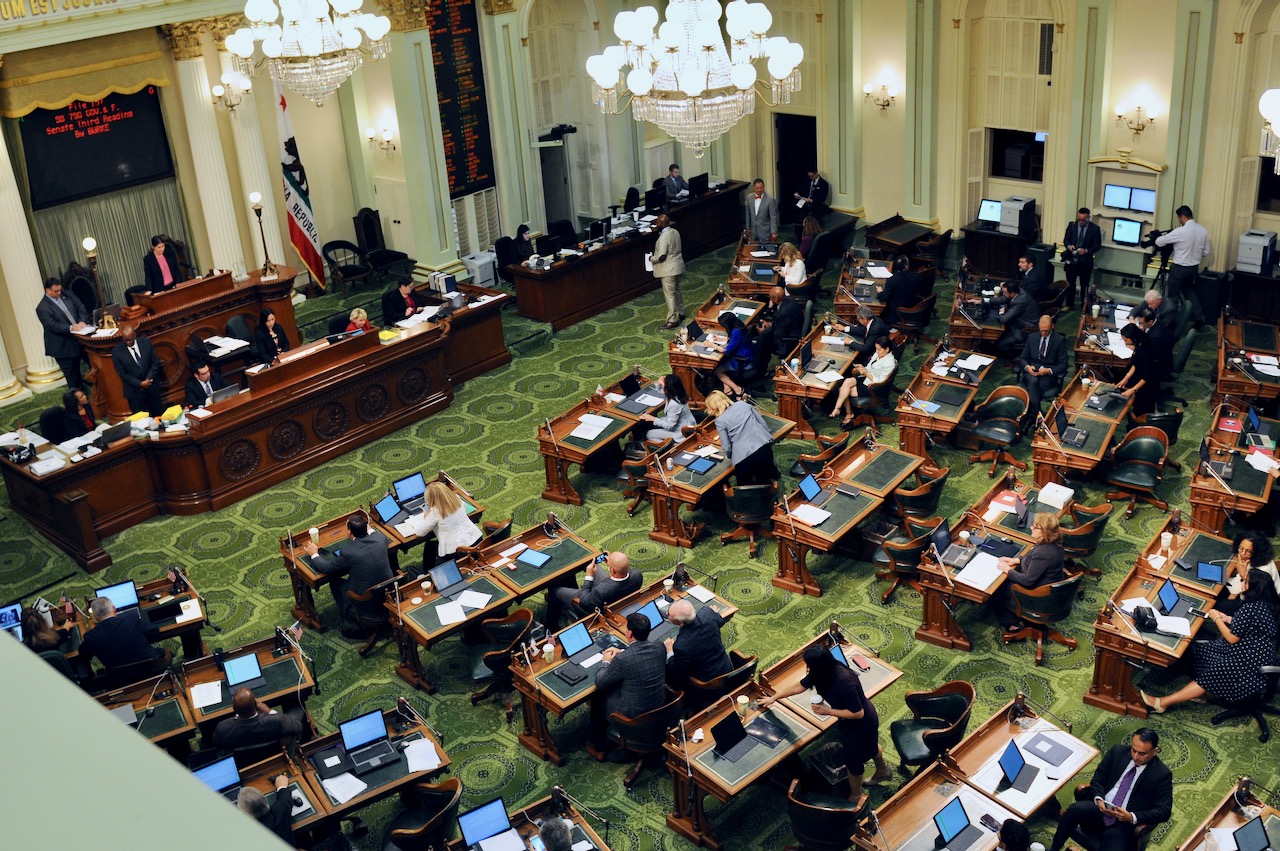
California State Assembly in Session. (Photo: Kevin Sanders for California Globe)
Are Legislative Findings in Prop. 11 Bills Sufficient?
The bill merely states the legislative finding and declaration without any further justification or explanation provided
By Chris Micheli, January 17, 2024 12:23 pm
In reviewing recent legislation that proposes amendments to California’s Emergency Ambulance Employee Safety and Preparedness Act, as enacted by the voters by Proposition 11 in November 2018, the same legislative finding and declaration is made in a bill. It is a simplistic statement that raises the question whether this language meets the requirement of Prop. 11.
The following is the standard form language contained in these bills:
The Legislature finds and declares that Section 1 of this act, which amends Section 884 of the Labor Code, is consistent with, and furthers the purpose of, the Emergency Ambulance Employee Safety and Preparedness Act.
Prop. 11 enacted an initiative statute that, in Article 2 of Prop. 11 (which is contained in Labor Code Section 881), provides the following Findings and Declarations:
ARTICLE 2. Findings and Declarations.
Section 881. The People of the State of California find and declare the following:
(a) California has the nation’s largest population, third largest landmass, and is prone to natural disasters such as earthquakes, wildfires, and floods. These circumstances demand a well trained emergency ambulance workforce.
(b) In California, private companies provide the primary emergency medical technician (EMT) and paramedic services for 74% of state residents. Unfortunately, catastrophes like natural disasters, active shooters, and mass casualty incidents occur far too frequently throughout the state and nation. Like all other first responders, emergency ambulance employees such as EMTs and paramedics must be adequately trained and available to respond to all types of crises and pleas for help.
(c) Private companies that employ emergency ambulance employees such as EMTs and paramedics should be required to provide compensated yearly training to prepare them to handle active shooter and mass casualty incidents, in addition to natural disasters.
(d) It takes a special type of person to be an emergency ambulance employee like an EMT or paramedic dedicated to serve, protect, and provide life-saving services for their fellow neighbors around the clock. Emergency ambulance employees such as EMTs and paramedics often witness traumatic events. Employers should provide mental health services to emergency ambulance employees.
(e) Emergency ambulance employees such as EMTs and paramedics work hard, and can be called into action at any time during their work shift to provide life-saving care. Therefore, it is important that they receive adequate meal and rest time to remain at their peak performance.
Furthermore, Prop. 11 contains in Article 3 of Prop. 11 (which is contained in Labor Code Section 882), the following Statement of Purpose:
ARTICLE 3. Statement of Purpose.
Section 882. The purpose of the Emergency Ambulance Employee Safety and Preparedness Act is to enhance public health and safety by ensuring that emergency ambulance employees such as EMTs and paramedics receive adequate training, meal and rest time, and mental health benefits, and are available to respond to 911 emergency-type requests for medical assistance at all times.
In addition, Prop. 11, in Article 5, provides the following related to amending the Act by the Legislature:
ARTICLE 5. Amendment.
Section 890. The Legislature may amend this Chapter by a statute passed in each house of the Legislature by rollcall vote entered into the journal, four-fifths of the membership concurring, provided that the statute is consistent with, and furthers the purpose of, this Chapter. No bill seeking to amend this Chapter may be passed or ultimately become a statute unless the bill has been printed and distributed to members, and published on the Internet, in its final form, for at least 12 business days prior to its passage in either house of the Legislature.
Prop. 11 was a statutory initiative enacted by the People and allows the Act to be amended by the Legislature. It specifies that any provision of the Act may be amended by a 4/5 vote of the Legislature, so long as that amendment “is consistent with and furthers the purposes” of the Act.
Recall that Article II, Section 10 of the California Constitution provides in Subdivision (c):
The Legislature may amend or repeal a referendum statute. The Legislature may amend or repeal an initiative statute by another statute that becomes effective only when approved by the electors unless the initiative statute permits amendment or repeal without the electors’ approval.
This provision only allows an initiative that was adopted by the state’s voters to be amended by the Legislature (such as Prop. 11) if the initiative permits amendment without the electorate’s approval. Prop. 11 does allow amendment by the Legislature as described above.
As a result, the Legislature may amend Prop. 11. So, when the Legislature desires to amend Prop. 11, it includes in a “plus section” (which can be seen at the end of a bill that proposes to amend the Act) a legislative finding and declaration. The following is an example of what is currently contained in Prop. 11 amendment bills:
The Legislature finds and declares that Section 1 of this act, which amends Section 884 of the Labor Code, is consistent with, and furthers the purpose of, the Emergency Ambulance Employee Safety and Preparedness Act.
The question to address is whether the language in the above example is sufficient or if there should be some explanation why the Legislature believes that Prop. 11’s purposes are being furthered by the proposed amendment.
The Legislative Counsel’s Digest includes the following description:
Existing law authorizes the act to be amended by a statute enacted by the Legislature with a 4/5 vote that furthers the purposes of the act. This bill would make legislative findings to that effect.
Unfortunately, bills amending Prop. 11 that contain a simple statement as set forth above do not in any way explain why the Legislature actually believes the proposed amendment “is consistent with and furthers the purpose” of the Act. Instead, the bill merely states the legislative finding and declaration without any further justification or explanation provided.
As with other bills that require legislative findings and declarations, should the bills that propose amendments to Prop. 11 include reference to any of Prop. 11’s specified purposes (there are five of them in Article 2 of the Act)?
This approach, providing a short explanation, is the approach often taken with urgency clauses and special statutes. If courts examine the urgency clause or special statute findings, there is at least a short sentence or paragraph that explains why the Legislature has determined a particular bill needs an urgency clause or why the bill qualifies as a special statute.
So, perhaps the bills that propose to amend Prop. 11 should also provide some rationale for their proposed amendments so that, if the legislation were challenged in litigation, courts would have a basis for understanding why the Legislature determined the bill made an amendment to Prop. 11 furthered its purposes.
As a result, the Legislature should consider adding some explanatory language to their simple statements in Prop. 11 amendment bills going forward. And, these bills should include language regarding how the bill complies with the specified procedural requirements in Prop. 11.
- Port Infrastructure Financing in California - August 18, 2025
- A Quick Look at the Last Part of the California Legislative Session - August 17, 2025
- Procedural Provisions for Family Law Judicial Determinations - August 16, 2025







